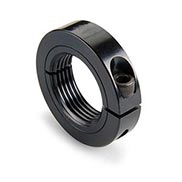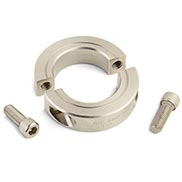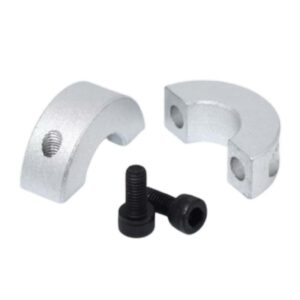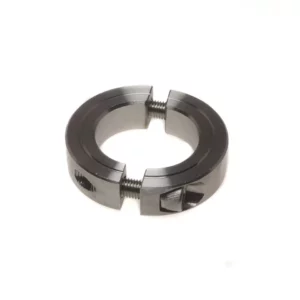Set Screw Shaft Collars
As one of leading shaft clamp manufacturers, suppliers and exporters of mechanical products, We offer shaft clamp and many other products.
Please contact us for details.
Mail:[email protected]
Manufacturer supplier exporter of shaft clamp
Set screw shaft collars are the most effective when used on a shaft made of softer material than the set screw. SSJ set collars are furnished exclusively with forged socket set screws for greater torque capacity and improved holding power. Forging the stainless steel set screws has the additional benefit of work hardening, resulting in stainless steel with elevated hardness and performance. Set screw shaft collars are made from 1215 lead-free steel with a proprietary black oxide finish, 303 stainless steel, high-strength 2024 aluminum, and engineered plastic. Bore sizes range from 3/16″ to 4″ and 4mm to 50mm.
Features
- Forged socket set screws
RoHS3 and REACH Compliant
- Width tolerance: +.003”/-.010”
- Bore tolerances for SC styles:
Up to 1”: +.0005” to +.002” 1-1/16” to 3”: +.0005” to +.003” 3-1/16” to 4”: +.0010” to +.004” - Temperature Range (Deg. F)
Steel: -40° to 350° Aluminum: -40° to 225° Stainless: -40° to 350° Plastic: -10° to 185°
A collar is a machine component that is simple in design yet plays an important role in a wide range of industrial applications. They serve three main functions; holding a component in place, positioning or positioning a component on a shaft, and creating a connection between a shaft and another component. Designers need to consider various factors, such as style, material, aperture and shaft geometry, before making a choice. Determining the requirements, parameters, and limitations of your system is important in determining the correct style for your application.
Set Screw (Solid)
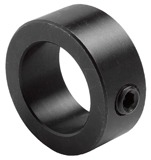
Clamping (Split)
Clip-on collars are available in one-piece and two-piece designs and solve many of the functional issues that arise with set screw collars. They use pressure to lock the collar to the shaft, unlike set screws which do not damage the shaft. Therefore, the clamping ring is easy to remove, adjust and adapt to almost any shaft. Additionally, when the clamping screw is properly tightened, the clamping force is evenly distributed over the circumference of the shaft. This is much safer than the point contact of the set screw ring; up to twice the holding force.
Bore diameter, concentricity, and fastening hardware all affect clamping ring retention. Hardware size, thread quality, tensile strength, and tolerances all affect the amount of torque a screw can transmit to the collar. Forged screws are generally preferred over broached screws, and the collar material must be strong enough to withstand the recommended torque without cracking or deforming.
How to Choose the Right Shaft Collar
There are many factors to consider when specifying a collar for your application. These include retention forces, operating conditions, mounting mechanisms, and materials.
A key performance factor designers typically look for in a collar is its retention. In a set screw ring, the holding force depends on the material of the shaft, as this affects how far the screw strikes the shaft. In clamping rings, bore diameter and concentricity are more important in calculating the retention force of the ring.
Collar retention can be further improved by opting for a black oxide finish. Due to its anti-stick properties, this enhances the collar’s hold while helping to maintain torque ratings.
If you are looking for corrosion-resistant collars, you can opt for galvanized collars. This provides excellent corrosion resistance, making it ideal for wet and contaminated environments. However, galvanizing reduces the retention of the collar.
The material of the collar and screws also affects the performance of the collar. Aluminum is a popular choice for its lightweight collar and good grip. Steel may be the right choice if you’re looking for the highest level of grip. For improved corrosion resistance, stainless steel is usually the material of choice.
It is important to ensure that the collar and the screw suit the operating environment. Too often, designers specify the perfect collar for an application and forget about the screws. While collars can withstand harsh environments, screws cannot, leading to degraded performance and premature failure.
While most collars are made of aluminum, steel, or stainless steel, some less common materials are available. Plastic collars are lightweight and inexpensive but offer much less support. Titanium collars are expensive but do not outgas, making them ideal for cleanroom environments.
Selecting the proper collar is an important part of the application design process. Choosing the wrong collar can affect your performance and lead to premature and machine failure.
If you are unsure when to choose the right collar for your application, it is best to consult an SSJ specialist [email protected].
Shaft Collar Applications
Collars have a wide variety of applications, so the following are just a few of the many options available.
They are used with automated machines. For precise automated operations, collars serve a variety of purposes, including locating and aligning bearings, gears, pulleys, and other moving parts. In trucks and off-road vehicles, collars act as mechanical stops for cylinders, actuators and other components.
Collars are used as precise and easily adjustable stops and spacers in laboratory equipment such as grips and frames. They can also be used on plastic, glass and thin wall tubing. Likewise, they are used as guides, stops and spacers for gears in medical equipment, such as adjustable hospital beds and positioning systems for MRI and CT machines. Collars have precise characteristics that meet the stringent requirements of medical devices, making them very useful in this field.
Collars are often used in optical measuring instruments for precise positioning and fine-tuning functions. They are also used in power transmission operations to aid in the positioning of motors and transmission components.
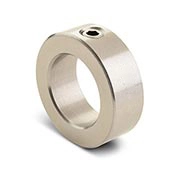
 RoHS3 and REACH Compliant
RoHS3 and REACH Compliant

